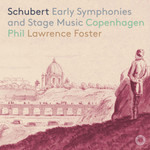|
Back
05/04/2019
“Schubert: Early Symphonies and Stage Music”
Franz Schubert: Symphony n° 1 in D major, D.82 – Symphony n° 2 in B-Flat major, D.125 – Symphony n° 3 in D major, D.200 – Overture in the Italian Style in D major, D.590 – Incidental Music to Rosamunde, D.797
Copenhagen Phil, Lawrence Foster (conductor)
Recording: Concert Hall of the Royal Academy of Music, Copenhagen, Denmark (October 2017) – 127’31
Pentatone # PTC 5186 655 [SACD Hybrid Multi-channel] (Distributed by Naxos of America) – Booklet in English

   
Since Franz Schubert only lived to age 31, the pace of musical output and complexity is remarkably compressed. Pentatone’s release makes great sense by focusing on ‘early Schubert’ and delivering it to the audience in absolute chronology. From this perspective, a complete listen-through reveals how the Viennese’s initial symphonic constructs were bounded more closely around his contemporaries, only to blossom into an independence in style and refreshing conviviality all his own.
Native Angelino, Lawrence Foster has a global resume that has touched several sectors of classical music, including the recent release of Richard Strauss’ music, featuring violinist Arabella Steinbacher. When it comes to the maestro’s approach, Franz Schubert’s music is messaged by realistic truth. Respect seems a consistent mantra in the conductor’s mindset. Alongside this quotient, Franz Schubert’s spotlighted instruments are cleanly cited and delivered.
Tempered with Haydn and Mozart, Schubert’s Symphony n° s 1 and 2 have their own sense of body and color; however, the Copenhagen Phil’s incessant, methodical progressions during livelier movements of the “Allegro vivace” [Symphony n° 1] and the “Presto vivace” [Symphony n° 2’s] are the biggest standouts, as they pop with a grand posturing.
From a historical perspective, the biggest treat rests inside the Symphony n° 3, showing Schubert flying on his own wings, erring more in the Romantic land while still hanging on to vestiges of Beethoven. The first movement’s second tempo (ref: “Allegro con brio) even thinly whiffs at Auber (2’02)(ref: clarinet.) It’s hard imagining Franz Schubert only age 18 years when he completed this piece. The “Allegretto” is pure happiness. A sense of carefree parlance circles around the “Menuetto. Vivace” with a delicate oboe/bassoon conversation that helps add to the symphony’s joy. The concluding jaunty tarantella, “Presto vivace”, is one of the crowning touches which Lawrence Foster builds to a beautiful climax. Perhaps this entire symphony breathes amiability since this was a fructuous time in Schubert’s life.
Another musical delight is the impish discussion eventually opening up to Rossini devotions (2’48) during the Overture in the Italian Style. Flutes and other woodwinds happily flounce about in breezy fashion. This composition is a fitting bridge to the dramatic Rosamunde incidental music. This music, written for the play by Wilhelmina von Chézy, Rosamunde Prinzessin von Zypern, has a tented statement of royalty, altogether separate from the other selections. The “Entr’acte n° 3” is the one of the most well recognized melodies in the classical canon, although the concluding “Ballet Music n° 2” has more universality, and it moves along with M. Foster’s carefully measured cadences.
Lawrence Foster doesn’t over-think the music, and his logic is keen. “Consistent, forth-right delivery.” In particular, consummate kudos go to Lawrence Foster who maintains Franz Schubert’s rapidly paced lines that could easily run without aid of a metronome. There’s unity and well-planned concatenation.
Christie Grimstad
|